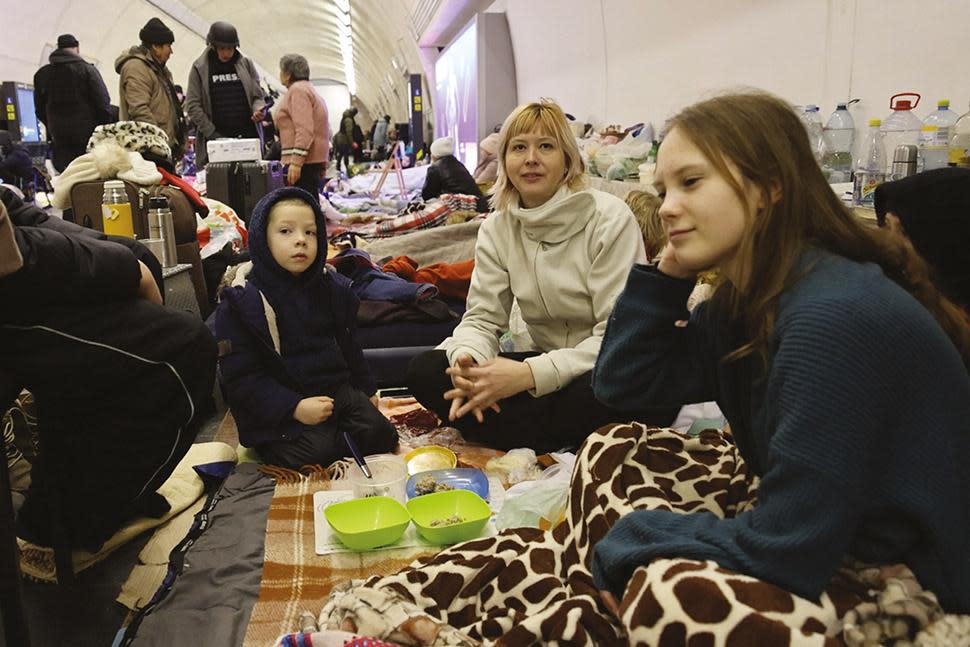‘Freedom on Fire: Ukraine’s Fight for Freedom’ Review: Evgeny Afineevsky Captures the Brutality of Putin’s War

- Oops!Something went wrong.Please try again later.
- Oops!Something went wrong.Please try again later.
A documentary titled “Freedom on Fire: Ukraine’s Fight for Freedom” doesn’t seem like a place for understatement, but it’s filled with moments where victims of the war in Ukraine turn to the camera and plainly speak devastating truths. In one such moment Maria, a television journalist, turns to the camera and near-whispers, “War remains incomprehensible.”
Evgeny Afineevsky’s sequel to Maidan Uprising doc “Winter on Fire: Ukraine’s Fight for Freedom” takes place in the early stages of the invasion of Ukraine. We begin with an effective but frantically paced animated summary of Ukraine’s history, beginning 1,200 years ago and through wars, occupations, and catastrophes. No matter what borders took hold or occupying forces said, the film maps out how Ukraine became its own distinct country that refused to be swallowed whole by Russia.
More from IndieWire
'The Damned Don't Cry' Review: A Loose Remake of Pier Paolo Pasolini Finds New Blood
'Beyond the Wall' Review: A Blind Man Shelters a Woman on the Run in Iran
From there, “Freedom on Fire” employs a more traditional documentary structure, cutting between interviews, phone audio, news clips, and sweeping drone footage of the smoldering embers of shelled cities. Afineevsky wants to hold the audience’s feet to the fire and have them fully absorb the staggering human cost of what Putin’s “demilitarisation and denazification” entails.
Such moments aren’t for the faint-hearted. The film starts off gently enough, with a comedy show in an air raid shelter, where a stand-up takes the mic and sends the crowd into applause by saying that “the Russian soldiers look like Orcs on bath salts.” But by the half-hour mark, “Freedom on Fire” unleashes images of children trapped under collapsing roofs and women in labor dying, their bodies punctured by shrapnel. By the hour mark, there are corpses strewn in the street and the blackened torn-off hands of the executed impaled on fences. The documentary seems caught between images that shock and the dignity of the film’s many other subjects.
Many of those subjects are traumatized from the beginning. Afineevsky returns to the Maidan Uprising as a clear starting point for the war in parallel to the swelling Russian propaganda machine, seeding information from Putin that Ukraine was posing a serious threat that had to be dealt with. Despite that build-up, as a hollow-voiced doctor grimly recounts, “We were not prepared.” Subjects are so broken by what they have experienced that they take on a detached, unnervingly matter-of-fact way of speaking, as if it was not their home destroyed or relatives who died. Others, often mothers clutching their children, are unable to do much more than sob.
There’s little examination of the geopolitical stakes outside thous bounds, as this is a film focused on the human toll of Putin’s brutality. That means other uncomfortable truths get lost along the way. We see the families devastated and fleeing on trains to Poland, but no space is given to the many reports of Black and brown people banned from boarding planes by racist mobs. To include those elements would not undermine the suffering of the Ukrainian people, but instead could have offered a more complex picture of how suffering does not dignify mankind.
As calls to action from those attending European film festivals go, this is a more effective move than Zelensky being broadcast to bewildered cultured journalists at Cannes. Despite Zelensky’s status as a public figure, save a few short clips, the film shows little interest in positioning Ukraine’s leader as the face of the conflict. Instead, we are most poignantly left with the image of a young girl, walking through the rubble searching for a new cat after hers was “burned with the house.” She, like many of the children, seems the most pragmatic of the survivors, looking for small solutions to distract from the world collapsing around them. No cell service or heat is a nightmare, made worse by a smiling face that just wants to play a game on one of their parent’s phones.
It’s a challenge to conclude a documentary on an ongoing and fast-evolving conflict. The news will continue to tally up the dead bodies and destroyed cities, from which the film refuses to allow us to distance our emotions. But where “Freedom on Fire” proves valuable isn’t in the brutality of the corpses but in the reminder that these are individual people being broken, and real families being torn apart. A priest says in his interview that the glimmers of hope are the most powerful. “How to stay human,” he says, shaking his head. “That is the hardest and most important part.”
Grade: B-
“Freedom on Fire: Ukraine’s Fight for Freedom” premiered at the 2022 Venice Film Festival. It is currently seeking distribution.
Best of IndieWire
From 'Barbie' to 'Babylon,' Here's Everything Margot Robbie Has in the Works
New Movies: Release Calendar for September 2, Plus Where to Watch the Latest Films
'White Noise': All the Details on Noah Baumbach's Film Starring Adam Driver and Greta Gerwig
Sign up for Indiewire's Newsletter. For the latest news, follow us on Facebook, Twitter, and Instagram.

